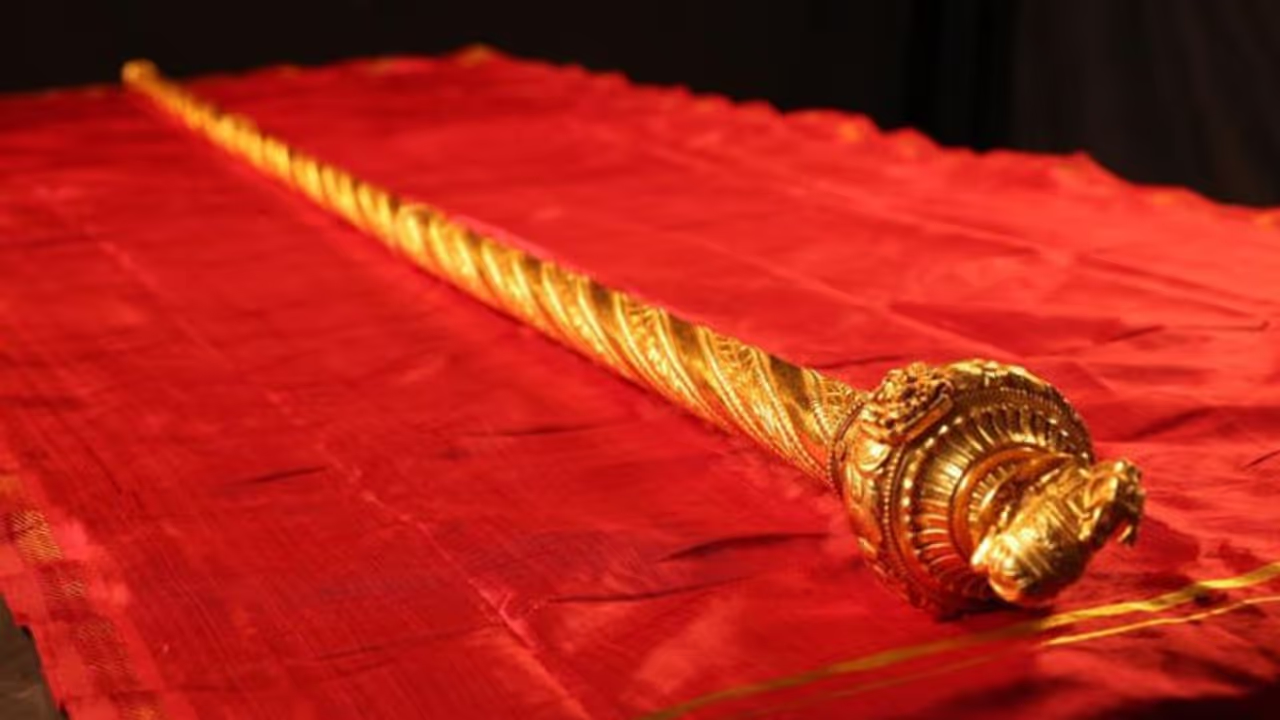It was a traditional Chola practice for Samayacharyas (spiritual leaders) to lead the coronation of kings and sanctify the transfer of power, which is also considered a kind of recognition for the ruler, says Prof S Rajavelu, formerly with the Department of Maritime History and Marine Archaeology of Tamil University.
The 'historical and sacred sengol (sceptre)' received by first Prime Minister Jawaharlal Nehru symbolising the transfer of power from the British to India in 1947, and set to be installed in the new Parliament House on May 28 by Prime Minister Narendra Modi, harks back to Tamil history from the Sangam age over 2,000 years ago.

It was a traditional Chola practice for Samayacharyas (spiritual leaders) to lead the coronation of kings and sanctify the transfer of power, which is also considered a kind of recognition for the ruler, says Prof S Rajavelu, formerly with the Department of Maritime History and Marine Archaeology of Tamil University.
"Tamil kings had this sengol (a Tamil word for sceptre), which is a symbol of justice and good governance. The two great epics Silapathikaram and Manimekalai records the significance of a sengol," he said.
The use of a 'sengol' has been popular since the Sangam age, he said, adding, "The Tamil classic Thirukkural hails the importance of the sengol. There is a whole chapter on the sceptre (titled sengonmai)," he said.
It was the head of ancient Shaivite math Thiruvavaduthurai Aadeenam math that presented the Sengol to Nehru in 1947, Rajavelu told PTI.
"We have inscriptions dating back to the Chola era that have a reference to the Thiruvavaduthurai Aadeenam," said Rajavelu, who previously worked with the Archaeological Survey of India for over two decades as an epigraphist.
In Tamil, the word 'Aadeenam' refers to both a Shaivite monastery as well as the head of the Shaivite math.
"This is among the Tamil Shaivite monasteries that did excellent work in the field of education, nurturing Tamil and the propagation of spiritualism," he said.
Following the Chola era tradition, the pontiff of the Thiruvavaduthurai Aadeenam presented the 'sengol' to the first Prime Minister of India Nehru signifying the transfer of power from the British to Indian hands.
Mayiladuthurai based Pannai T Chockalingam, who is closely associated with Shaivite monasteries such as the Dharmapuram Aadeenam and Thiruvavaduthurai Aadeenam said: "It was our Rajaji (C Rajagopalachari, last Governor General of India) who convinced Nehru that such a ceremony was needed, saying 'Bharat' has its own traditions and that the transfer of sovereign power should be presided over by a spiritual guru."
Chokkalingam, the State chief of the Tamil Nadu Saiva Vellalar Sangam and a Congress functionary for decades said it was Rajaji who underscored that Thiruvavaduthurai Aadeenam was an ancient monastery which could be assigned the responsibility of making the sengol, and this suggestion was accepted by Nehru and it happened as proposed.
"This sengol was made and presented in keeping with traditions dating back to the Chola era," the octogenarian said.
Vummidi Ethirajulu, 96, and Vummidi Sudhakar, 88, two people who were involved in the making of the original sengol in 1947 are expected to attend the new Parliament building's inauguration.
Chokkalingam said that in Tamil culture, Aadeenams traditionally presided over events that marked the transfer of sovereign power and it was such spiritual leaders who presented the sceptre to leaders who were bestowed with the responsibility of leading the nation.
"Our Othuvamurthis (Tamil word for scholars in Shaivite scriptures and hymns) rendered the Thevaram hymn Kolaru Pathigam authored by saint Thirugnana Sambandar and the singing of this devotional song and presenting of the sengol marked the transfer of power when India became independent," he said.
The 'Thevaram' spiritual hymns of the Chidambaram temple written in palm leaf manuscripts were recovered by emperor Rajaraja-I (985-1014) who earned the title 'Thirumuraikanda Cholan', Rajavelu said.
"This song is for the welfare of everybody; the country and its people and devotees," Chokkalingam said, adding that the iconic nadaswaram maestro T N Rajarathinam Pillai (1898-1956) had rendered the song in 1947.
At the time of the transfer of power on August 14, 1947, three people were specially flown in from Tamil Nadu the Deputy high priest of the Adheenam, the Nadaswaram player Rajarathinam Pillai and the Othuvar (singer) who came carrying the Sengol and conducted the proceedings. Mayiladuthurai, where Chokkalingam lives, is just 14 km from Thiruvavaduthurai.
According to the 2021-22 policy note of the TN Hindu Religious and Charitable Endowments Department: "At the time of enthronement, the traditional guru or the preceptor of the king would handover the ceremonial sceptre to the new ruler."
Following this tradition, when the Othuvamurthis completed the singing of the last line of 11th stanza from Kolaru Pathigam-Thevaram, Thiruvavaduthurai Aadeenam Thambiran Swamigal (pontiff) handed over the gold-plated silver sceptre to Pandit Jawaharlal Nehru.
"This signified the transfer of power from British Governor General Lord Mountbatten to the first Prime Minister of India."
